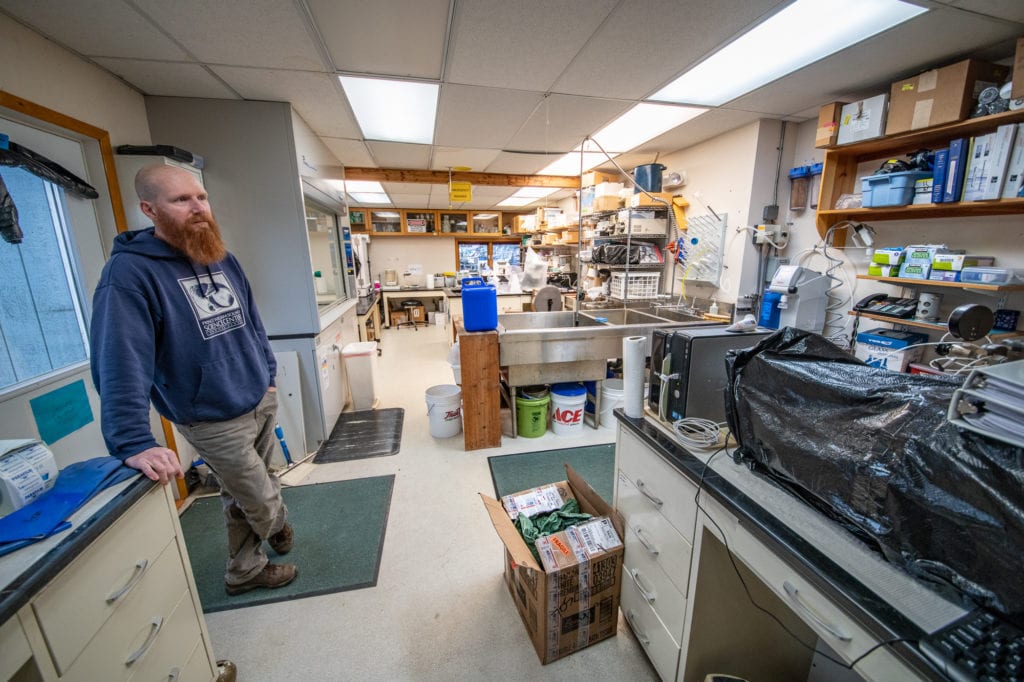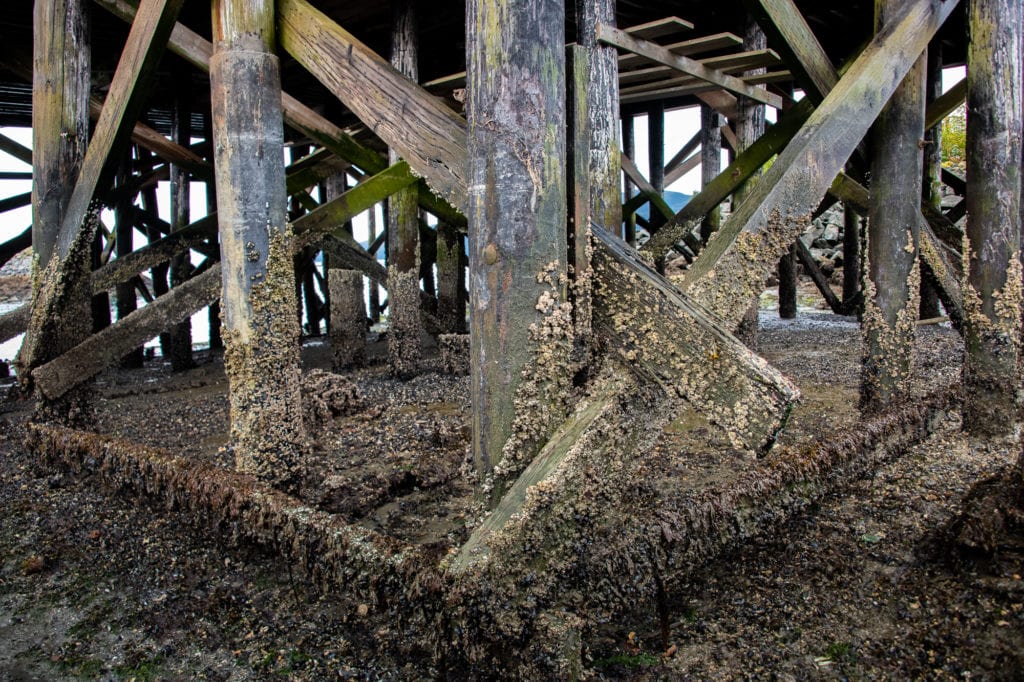
Four hundred square feet is just the right size for a studio apartment or a two-car garage. For an all-purpose science lab, however, it’s extremely snug. Nonetheless, 400 square feet is what researchers at Prince William Sound Science Center’s laboratory have to work with.
“It’s nice being at the mouth of the harbor,” PWSSC oceanographer Rob Campbell said. “The views are pretty great. But it’s just so small… It’s a crazy-small place to be doing everything from chemistry to processing fish samples in.”
PWSSC’s laboratory is found inside a two-story building that could be mistaken for a large house. The building rests on dock pilings near the edge of Cordova Harbor. These pilings, which have grown increasingly unsteady and barnacle-encrusted, pose an additional problem. Anytime a truck drives up the building’s wooden ramp, the vibrations play havoc with certain kinds of microscope work.
“Our game here is ‘earthquake or field truck,’ because they both feel about the same,” Campbell said.
Some scientists choose to work outside of office hours just to avoid the risk of microscope-deranging trucks, Campbell said. Even without the issue of trucks, the subtle wobbliness of the building’s dock pilings make it impossible to use microbalances and other sensitive measuring devices.
Everything in the small space is stowed with nautical efficiency — to casually leave one’s backpack in the lab overnight would be unthinkable. At the center of the room is a safety shower, used to wash off hazardous chemicals in the event of an accident. Directly beneath the showerhead is a drain, which would be far more useful if the floor weren’t perfectly flat. As it is, Campbell says, any use of the safety shower would flood the entire lab.
“In a real lab, the floor is pitched, so the drain is at a low point,” Campbell said. “Once, somebody left the sink running and completely flooded the lab. For a time, we made sure that everything was up off the floor… It may be time to revisit that, because they’re going to have a huge mess if they have another flood.”
Conducting research in a lab the size of a dorm room gives rise to an endless series of complications: epifluorescence microscopy, which requires darkness, can only be accomplished by taping garbage bags over the windows. Meanwhile, researchers are forced to grind up salmon samples in a small trailer outside the building so as not to contaminate other researchers’ work with powdered fish.
Yet, despite these sitcom-like mishaps, scientists continue to arrive from around the U.S. to do work in PWSSC’s lab. The Cordova area, which combines tidewater glaciers, wetlands, rainforest, rocky shorelines and anadromous fish habitats, provides a unique opportunity for life scientists.
“It’s kind of invisible to Cordova, but there are people who come here from all over the country to do research,” said Katrina Hoffman, president and CEO of PWSSC. “It often happens during the fishing season, so you may not notice that there’s three or four folks out on the delta, coming here over and over on a multi-year, ongoing project.”

The science center was established in 1989, shortly after the Exxon Valdez oil spill. Now, settlement funds from the spill may offer the science center an exit from its cramped, wobbly home at the edge of Cordova Harbor. In October 2018, the Exxon Valdez Oil Spill Trustee Council approved funding for an expansive new campus built on roughly five acres of land purchased from the city of Cordova. The planned campus will centralize PWSSC’s scattered facilities and increase the combined square footage of its facilities from roughly 15,000 square feet to roughly 25,000 square feet. The site lies near a 120-acre property of the Copper River Watershed Project, raising potential for collaboration.
New lab facilities, aside from being large enough to keep researchers from blowing fish dust in one another’s faces, will offer access to running seawater. While some other research facilities have to work with seawater created from a Kool-Aid-like powdered mix, PWSSC will have access to “fresh” seawater piped from Orca Inlet. Running seawater will allow the center to keep ocean-dwelling organisms alive with lesser risk of water quality issues. It will also allow the center to maintain a touch tank, a table-like, open-topped tank containing shore-dwelling wildlife like starfish, urchins and limpets. In keeping with the requirements of the Exxon Valdez Oil Spill Trustee Council, the new center will continue to offer the public education on oil spill issues.
“When people walk up here, they think that, with the words ‘science center’ in our name, it’s going to be an interactive museum,” Hoffman said. “They walk in and go, ‘Hey, what can we do here?’ And the answer is: talk to someone or take some brochures. At the new facility, we’ll have interactive community engagement space, and more things for people to see and do when they walk in.”
PWSSC currently relies on a campground and an eight-person bunkhouse to put up visiting researchers. Otherwise, out-of-town scientists are forced to jostle with tourists and other visitors for accommodation space. A two-story dormitory will make it easier for larger groups, like college classes looking for field experience, to work with PWSSC, Hoffman said.
Perhaps the one thing PWSSC hasn’t escaped at its new location is unsteady ground. The campus’s 4,800-square-foot warehouse was initially planned to be erected on gently sloping terrain now occupied by a gravel parking lot. However, a geotechnical survey revealed that the ground beneath the parking lot though superficially solid, becomes watery 15-25 feet down. PWSSC would have to spent $1 million on underground pilings before so much as a wall could be raised over the area, Hoffman said.
As an alternative to building on top of the parking lot, PWSSC now plans to deforest and level part of a nearby hill. All in all, 10,000 to 20,000 square feet of forested ground will be modified, Hoffman said.
“Bedrock is all over the property, just not where the parking lot is,” Hoffman said. “It is what it is. It’s not consistent with what the original vision was, because the quality of the fill that exists there currently is very poor… We’ll have to be doing some more modification of the upland than was originally desired, but that’s the nature of the beast.”

Much remains to be decided about PWSSC’s new campus, including its price tag. Although broad outlines of the facility have emerged, engineers and architects are only just preparing to draw up the designs that will allow builders to make a precise cost estimate. Oct. 4, PWSSC received a National Environmental Policy Act assessment stating that the project will make no significant environmental impact. Hoffman hopes that the final design will include geothermal heat pumps, solar panels and other features that would reduce long-term energy costs. The project’s deadline is, in effect, December 2021 — the expiration date for PWSSC’s lease on its cozy Cordova Harbor facility.
While the trustee council has provided anchor funding for the project, PWSSC still must raise money to close the gap.
“There are foundations and corporations investing in our project because they recognize the value of what the science center has done over time, and they’re going to want to see a significant community commitment to the project’s success,” Hoffman said. “That’s both in material ways, through contributions of money, and through practical ways, such as statements and other expressions of support.”
One early expression of material and moral support came from the city of Cordova, which sold PWSSC their new property, valued at $68,800, for just $50,000. The city termed this a donation in kind. Hoffman encourages residents to donate in support of the project online, in person during business hours or by mail. PWSSC also plans to appeal to residents by sending out letters.
One group PWSSC won’t have to canvass too aggressively for support is Cordova’s scientific community.
“We are so crowded in here,” Campbell said. “I think, in terms of efficiency and ease of life, the new campus will be huge.”





